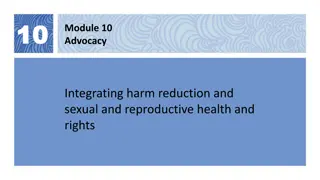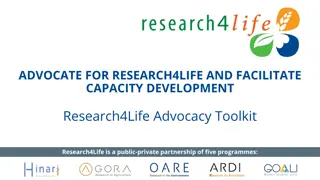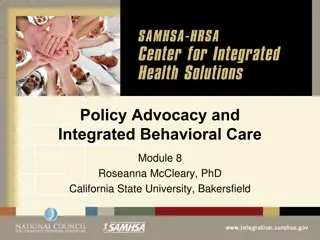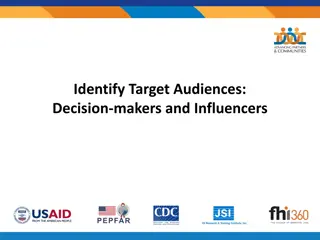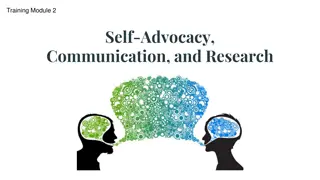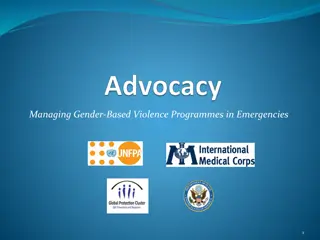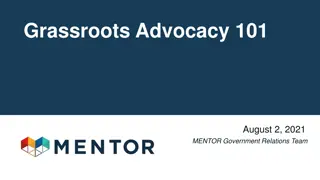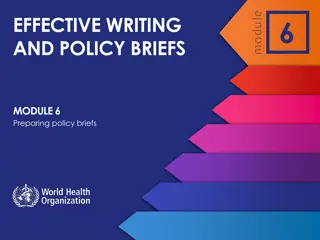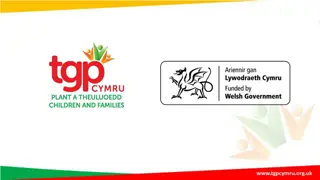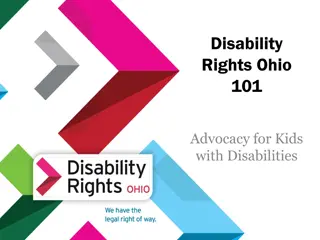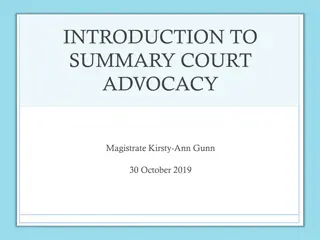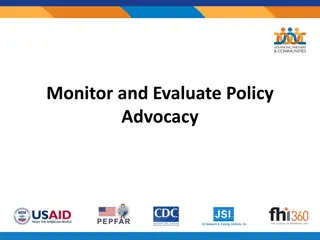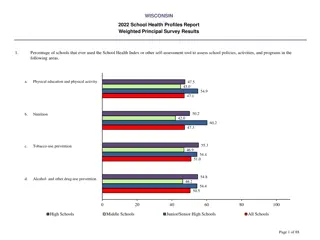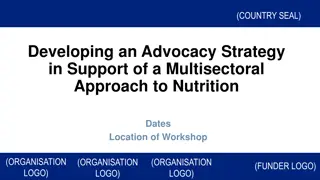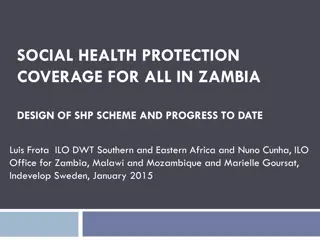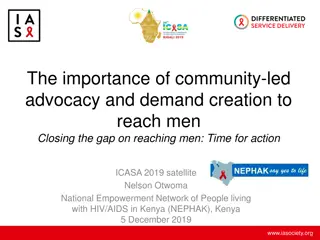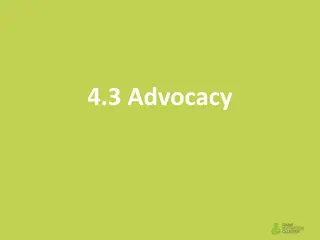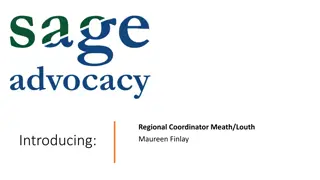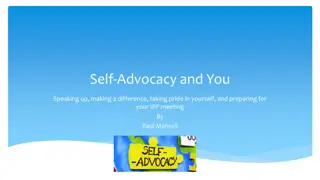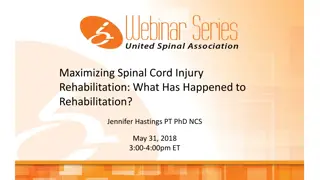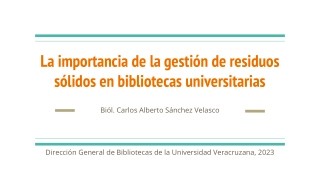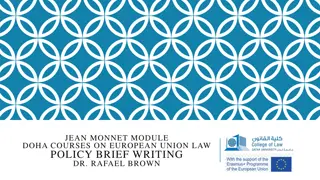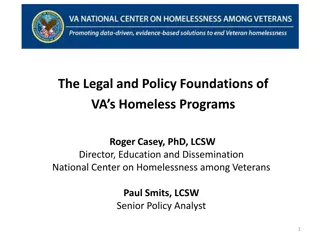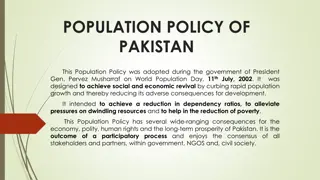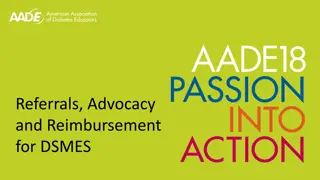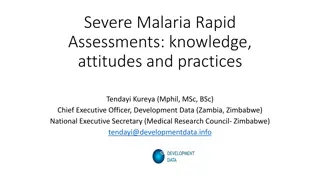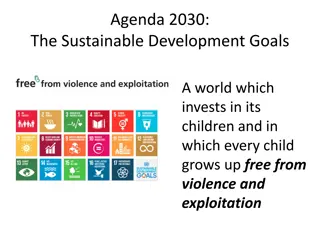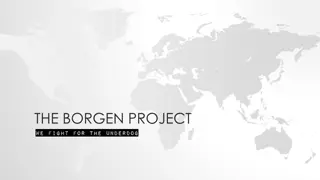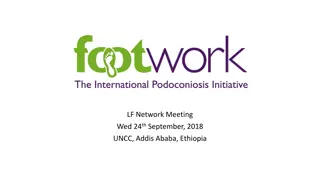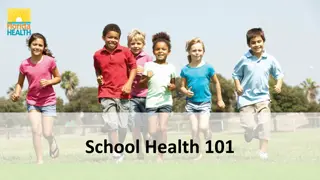Understanding Advocacy: Sensitizing Policy Makers for Health Programs
Advocacy involves the process of sensitizing and creating awareness among policy makers to gain their support and commitment for specific programs. It is a continuous effort that aims to influence decision-makers to support health interventions. Advocacy meetings play a crucial role in engaging community leaders and government officials to promote health initiatives and secure budgetary allocations for health projects.
Download Presentation

Please find below an Image/Link to download the presentation.
The content on the website is provided AS IS for your information and personal use only. It may not be sold, licensed, or shared on other websites without obtaining consent from the author. Download presentation by click this link. If you encounter any issues during the download, it is possible that the publisher has removed the file from their server.
E N D
Presentation Transcript
ADVOCACY BELLO C.B.
DEFINITION FMOH (2005) defined Advocacy as a process of sensitizing with subsequent follow up of policy makers and others to arouse their interest so as to get them committed to programmes. Advocacy is also defined as a set of actions undertaken by a group of individuals or an organization working in partnership to build consensus, gain support or create a favorable environment for introducing or changing specific strategies, programs, laws or policies
DEFINITION CONTD Olise (2007) stated that Advocacy is also the process of creating awareness concerning any programme among policy makers and others in order to solicit their support and commitment. Note that definitions emphasis is laid on sensitization, creating awareness and arousing interest of policy makers or leaders so as to support health programs. It is not a one day activity but a continuous process
CONCEPT OF ADVOCACY Much need to be done to mount an effective communication strategy for advocacy as regards any programme. There is very little awareness on the part of some policy makers about certain programmes especially as regards their rationale and benefits. Consequently, advocacy greetings and visits are necessary for the achievement of some major objectives of such programmes.
CONCEPT OF ADVOCACY CONTD Advocacy meetings are organized for Community leaders including Government functionaries, councillors, Local Government chairman, Traditional Rulers, Governors, Presidents, Legislators, Permanent Secretaries, Directors Commissioners of Health etc.
RATIONALE FOR ADVOCACY Rationale simply refers to fundamental reasons or ideas behind an activity. Advocacy is a very important strategy to achieve the objectives of any programmes especially health interventions Advocacy is usually made to policy makers and opinion leaders so as to influence them to support a cause or issue. To obtain increased budgetary allocation for health and health related projects. To provide the leaders the opportunity to identify with health programs and therefore act as models.
RATIONALE CONTD Advocacy is necessary for acquainting policy makers of their role and responsibility in relation to identified health goals. This will usually include explanations why such roles are important. When policy makers understand their roles and underlying reasons, they will be better disposed to provide the support and the help required from them. In view of the facts stated above one can adduce that Advocacy is necessary for the implementation of any health programme or any other programme.
STEPS IN ADVOCACY In order to carry out a successful Advocacy, there is the need to follow concrete steps to have contacts with policy makers and other groups that are relevant in the implementation of programme especially health programs. In order to follow the steps we must note the focus groups both at the Local Government, State and Federal Levels.
FOCUS GROUP IN LGA A. Focus groups for Advocacy at the L G A level 1. The Chairman 2. The Secretary 3. The Supervisory Councillor for Health 4. The LGA Co-ordinator (MOH) 5. The LGA PHC Committee 6. Traditional Rulers etc.
STEPS IN ADVOCACY AT THE LOCAL GOVERNMENT LEVEL 1. Make initial visit to LGA/Policy Makers. 2. Discuss with the LGA functionaries, the following: (a) Objective of the Programme; (b) The responsibility of the LGA, NGOs, communities and individuals; (c) Explain the National Health Policy as its relates to the Programme. (d) The need for proper implementation of the programme; and (e) Formation of management committees at various levels.
FOCUS GROUPS FOR ADVOCACY AT THE STATE LEVEL 1. The State Governor 2. House of Assembly Members 3. Commissioner for Health and others. Steps in Advocacy at State Level 1. Make initial visit to the Governor and other policy makers Discuss intentions and objectives of the programme as well as for them to launch the programme.
FOCUS GROUPS FOR ADVOCACY AT THE FEDERAL LEVEL 1. The President 2. Members of the National Assembly 3. Chief Executives of Federal Government Agencies and Parastatals. Steps in Advocacy at the Federal Level 1. Make initial visit to the President, Ministers and members of the National Assembly as well as other important in the system. Solicit for the launching of the programmes as well as expatiating on the objectives of the programmes and its relationship to the national Policy.
GENERAL STEPS IN ADVOCACY Proper understanding of the subject for advocacy: have good understanding of the subject for advocacy, you must have knowledge on all information on the issue. Identify purpose or need for advocacy: state the current situation and the problem on ground that necessitated advocacy
GENERAL STEPS IN ADVOCACY CONTD Clarify how the Identified problem can be solved: state how the problem can be solved, who and when it will be solved. Build partnership: identify allies and develop partnership to ensure greater support. Power of advocacy is seen in the quality and number of people who supports the idea. Select audience: identify the beneficiaries, partners, decision makers and adversaries, ensure that you get everyone to your side in order to have more support. Develop messages: messages must be carefully prepared & appropriate language must be used.
GENERAL STEPS IN ADVOCACY CONTD Develop communication channels: this to allow effective communication process. Advocate must possess good communication skills to convey the message to the audience, must also learn to use persuasive words. Ensure no time is wasted in delivering the message. Be brief and concise. Prepare for meetings and encounters: anticipate needs and possible questions that may be raised and prepare answers ready.
ADVOCACY STRATEGIES Coalition building: building alliance to broaden support Identification of opposition & development of strategies to address them: Try as much as possible to reduce the number of opposition Courting the media: ensure a good relationship with journalist and information officers Identification and cultivation of spokespersons: select advocates who can communicate effectively using the language that is culturally accepted Organizing political support: enlist the support of influential people e.g. grassroot politicians
ADVOCACY STRATEGIES CONTD Control your personal biases: be objective in discussions and avoid judgmental attitude Do not create enemies: develop capacity to handle opposition and resistance Reward participation and positive results: it s a good motivational tool Do not give up: persevere and aim at achieving success
PROCESS OF DESIGNING ADVOCACY MESSAGES The process involves series of things that are done in order to achieve results of Advocacy. Since, Advocacy is a means of seeking support to ideas, the methods to be used should be in the mainstream of activities. It will be necessary for individuals groups or organizations to formulate concrete action plans to enable Advocacy yield results.
PROCESSES /METHODS OF DESIGNING ADVOCACY MESSAGES 1. Invitation of key policy makers to take part in selected activities 2. Organise meetings with stakeholders 3. Joint/collaborative activities 4. Media (TV, print, Electronic, Radio) 5. Field Visits 6. Brainstorming 7. Lecture/ Symposium 8. Carnival floats 9. Press conferences 10. Rallies for public enlightenment on issue 11. Lobbying
PROCESS/ METHODS CONTD 12. Presenting data 13. Writing letter to policy makers 14. Petitions
1. Invitation of key Policymakers to take part in selected activities Advocacy messages should occupy the mainstream of the activities. Many organizations do this by inviting key policy makers to take part in selective activities such as training events and workshops, and often inviting them to open and or close the events. Basically there is the need to prepare and use a combination of specific tools and approaches
2. Organize meetings with stakeholders Arrange meetings with key people on the issue of concern and discuss extensively on the topic. State the objectives of the program, current state and expected state and areas where support is needed, who and how must be clearly stated.
3. Joint/collaborative activities Joint activities with members of the target audience could enhance advocacy through a working process. In collaborative activities, ideas of the advocates gradually become clearer to all involved, ensuring a deeper knowledge of the programme by the target audience. To convince senior officials in government, NGOs, and other relevant organizations of approaches behind any programme, there is need for them to participate in programme activities
4. Media (TV, print, electronic, radio) The use of various media can be used to share experiences and educate members of the target audience. When the main target audience consists of actors in policymaking, the media will probably be printed material and electronic media to enable policy makers understand the ideas behind the intended programme.
5. Field visits This involves the target group being taken out to visit some programmes/events that need to be carried out concerning the intended programmes. This is ideal for developing policy makers attitudes and influence decision making on the intended programme.
6. Brainstorming This is a critical examination of ideas, problems, situations and appraisal of issues between the campaigners/advocates and the target audience or policy makers
7. Lecture This involves a straight forward discussion, a pre- planned structured scheme delivered as a topic in a session. Here, the Advocates talk to the target audience about the intended programme including its objectives
8. Symposium This involves presentation of papers on relevant facts about the intended programme to the target audience in a venue. The idea is to express the full aspects of the intended, programme for the public to buy the idea and support its implementation
9. Lobbying This is a process of convincing individuals or members of the public on the need to support the intended programme. Lobbying and advocating with external institutions, organizations and people provide a weightier support base to convince or influence positively towards the intended program that needs implementation.
Presenting data This involves presenting data and other useful information on the health issue to a committee or a group of people
ADVOCACY MATERIALS In order for effective Advocacy to take place some materials including information, communication and audio visual aids are necessary. These materials are essential because, in order for an individual to accept or adopt a new behaviour he must pass through some stages which the materials must address.
ADVOCACY MATERIALS Advocacy materials and processes include information, communication, education, audio- visuals, flip charts, reference books and journals. These materials help to enhance advocacy messages in order to achieve the objectives of the intended programmes and satisfy the desires of the advocates.
USES OF ADVOCACY MATERIALS Advocacy materials is necessary for conviction and acceptance of the intended programme by the target audience. Advocacy materials are useful for: 1. Creating awareness 2. Motivating people and promote desired changes in behaviour of the target audience 3. Advocacy materials educate and inform people 4. They explain the need for change 5. Advocacy materials carry information that is easily understood, remembered and retained for future use.
CONCLUSION The success of advocacy depend on the commitment of the campaigners. The campaigners must believe in the issue of the subject of their campaign, even when they lose, let the loss be a reference point for hard work and not a setback. No matter the amount of preparation before deciding to use any of these methods, remember that the unexpected might happen but always have hope and believe in your potential success
REFERENCES Basavanthapa, B. T., Community Health Nursing (2nd edition). Jaypee brothers medical publishers , New Delhi Park, K. (18thediition) Park s textbook of preventive and social medicine. Banarsidas Bhanot Publishers, India. Olise, P. (2012) Primary Health Care for Sustainable Development. Ozege Publications Abuja
Thanks for listening



